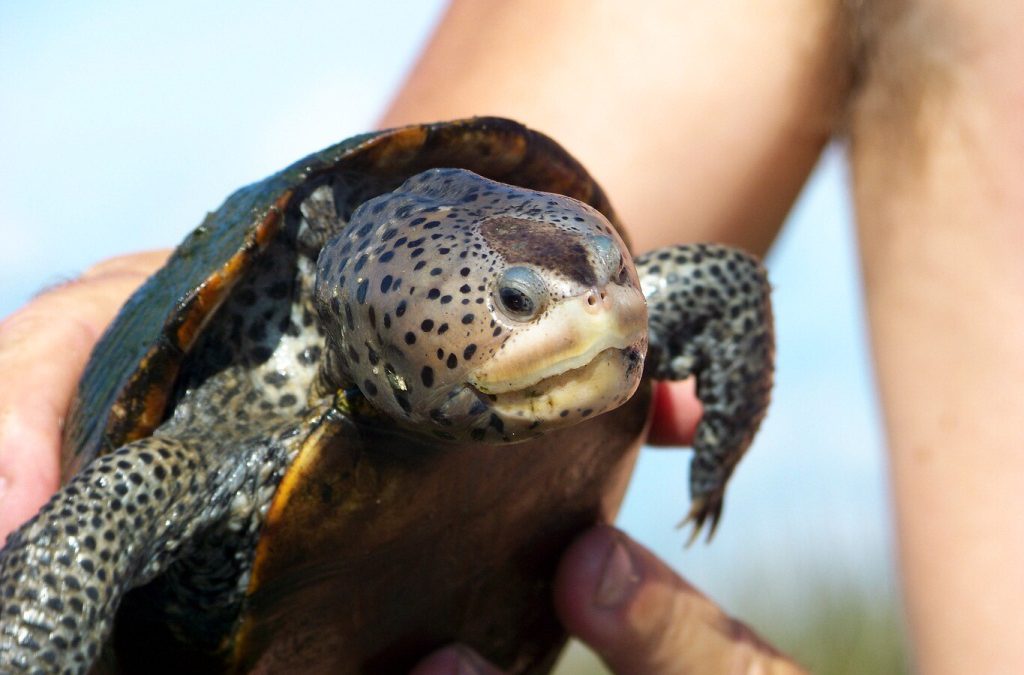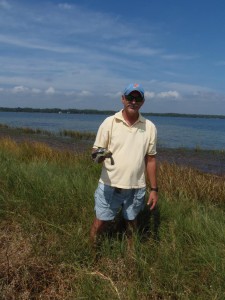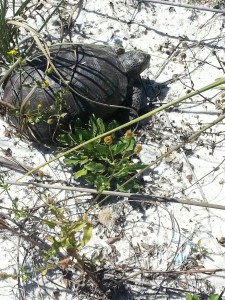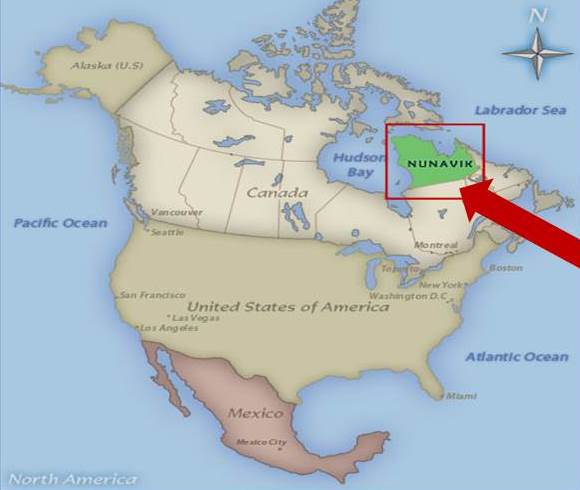
by Rick O'Connor | May 8, 2016
When doing programs about snakes I find plenty of people who hate them… but I have never found anyone who hated turtles. I mean what is there to hate? They are slower, none of them are venomous, they have shoulders… people just like them. And to that point, when people see them crossing the road almost everyone wants to help. But that can be dangerous – for you and for the turtle. Here are couple of safety tips you should know before helping a turtle cross the road.

This small turtle can be held safely by grabbing it near the bridge area on each side.
Photo: Molly O’Connor
Your Safety
You would be surprised by the number of people, particularly children, that are hit by cars while trying to help turtles cross the road. One story I heard involved nine-year-old girl who was riding in the backseat with her grandmother. They both saw the turtle trying to cross a busy highway and wanted to help. The grandmother pulled over to the side but before she could even get the car in park the little girl opened the door and ran into the highway only to be struck by an oncoming car. We all like turtles, and do not want to see them hit by cars, but as sad as it is to see a turtle hit – it is horrific to see the same happen to a child. No matter what your age – please watch for traffic before attempting to help a turtle.
Turtles Bite
Yep… unlike their reptilian cousins the snakes, lizards, and alligator, turtles do not have teeth… but they do have a beak. The beak is made of a hard bony like material that is blade sharp in carnivorous turtles, and serrated like a saw in herbivorous ones – both can do serious damage. Some species of turtles feed on a variety of shellfish, and if they can crush shell they can certainly do a number on your hand – so you have to be careful. First thing you should do is determine whether the turtle needs to be handled. If traffic is not too bad, or the road not too wide, you may be able to just manage traffic so the turtle can cross on its own. If you feel that you must handle the turtle, there are safe ways to hold them. Smaller turtles can be held safely from the sides by grabbing the bridge area – the portion of the shell connecting the top (carapace) to the bottom (plastron). Many turtles will begin to kick their feet when you do this and their claws may scratch – be prepared for this. There are two groups of turtles that have extended necks and your hands, grasped near the bridge of their shell, are still within range of their mouths – these are the snapping and softshell turtles. Both are notorious for their bites. So how do you handle those? Below is a short video put together by the Toronto Zoo that gives you some ideas on how to handle those situations.
https://m.youtube.com/watch?v=Lgd_B6iKPxU
Turtle Direction
Turtles cross highways for a variety of reasons – females looking for high dry ground to nest, individuals looking for more productive ponds, males looking for females – whatever the reason they are heading that way and will continue to do so. Placing them on the side of the highway where they came from will only initiate another attempt to cross. Move them to the side of the road they were heading.
The majority of turtle crossings occur during spring and summer. Untold numbers are killed each year on our highways – many gravid females carrying the next generation of the species. Though we encourage turtle conservation in Florida you do have to be smart about it. If you have any questions about Panhandle turtles in Florida contact your local extension office.

by Rick O'Connor | Apr 8, 2016

This gopher tortoise was found in the dune fields on a barrier island – an area where they were once found.
Photo: DJ Zemenick
The state of Florida has designated Sunday April 10 as “Gopher Tortoise Day”. The objective is to bring awareness to this declining species and, hopefully, an interest in protecting it.
During his travels across the southeast in the late 18th century, William Bartram mentioned this creature several times. As he walked through miles of open longleaf pine he would climb sand hills where he often encountered the tortoise. These turtles do like high dry sandy habitats. Here they dig their famous burrows into the earth.
These burrows can extend almost 10 feet vertically below the surface but, being excavated at an angle, can extend 20 feet in length. There is only one entrance and the tortoise works hard to maintain it. Field biologists have been able to identify over 370 species of upland creatures that utilize these burrows as refuge either for short or long periods of time. These include the declining diamondback rattlesnakes, gopher frogs, and the endangered indigo snakes, but most are insects and small mammals. Because of the importance of the burrows to these species, gopher tortoises are listed as keystone species – meaning their decline will trigger the decline of the others and can upset the balance of the ecosystem. Gopher burrows can be distinguished from mammal burrows in that they are domed across the top but flat along the bottom, as opposed to being oval. The width of the burrow is close to the length of the tortoise. When danger is encountered the tortoise will turn sideways – effectively blocking the entire entrance. Though there are cases of multiple tortoises in one, the general rule is one tortoise per burrow.
Tortoises are herbivores, feeding on a variety of young herbaceous shoots, and fruit when they can get find them. Fire is important to the longleaf system and it is important to the gophers as well. Fires encourage new young shoots to sprout. If an area does not receive sufficient fire, and the ground vegetation allowed grow larger with tougher leaves, the tortoise will abandon their burrow and seek more suitable habitat – which, especially in Florida – is becoming harder and harder to find. They typically breed in the fall and will lay their 5-10 eggs in the loose sand near the entrance of the burrow in spring. In August the hatchlings emerge and may hide beneath leaf litter, but will quickly begin their own burrows.
This tortoise is only found in the southeast of the United States and it is in decline across the region. They are currently listed as threatened in Florida but are federally protected in Louisiana, Mississippi, and western Alabama. They are found across our state as far south as the Everglades. There are several reasons why their numbers have declined. Human consumption was common in the early parts of the 20th century, and still is in some locations – though illegal. Some would, at times, pour gasoline down the burrow to capture rattlesnakes – this of course did not fare well for the tortoise. A big problem is the loss of suitable habitat. Much of upland systems require periodic fires to maintain the reproductive cycle of community members. The suppression of fire has caused the decline of many species in our state including gopher tortoises. These under maintained forest have forced tortoises to roadsides, power line fields, airports, and pastures. In each case they have encountered humans with cars, lawn mowers, and heavy equipment. Keep in mind also that our growing population is forcing us to clear much of these upland habitats for developments where clearing has caused the burial (entombment) of many burrows.
This is a unique turtle to our region and honestly, is a pleasure to see. We hope you will take the time to learn more about them by visiting FWC’s Gopher Tortoise Day website, enjoy watching them if they live near you, and help us conserve this species for future generations.

by Will Sheftall | Oct 26, 2014

“Within the past five years, nine of the 14 villages in Nunavik in northernmost Quebec have had to install cooling systems at community ice hockey arenas to keep the rinks cold during winter.“
– The Arctic in the Anthropocene: Emerging Research Questions
Have you wondered how Florida’s wildlife conservation policy planners and habitat managers are responding to the new management challenge of predicted coastal habitat loss from sea level rise? And how that overlays on predicted habitat loss from a 50-year doubling of Florida’s human population? Are the model predictions for both trends reliable enough to give planners a platform for recommending actions to ensure a habitable Florida for wildlife and for our grandchildren?
It’s a daunting task. The latest reports released by the Intergovernmental Panel on Climate Change (IPCC) [ http://www.floridaclimateinstitute-uf.org/new-ipcc-report-climate-change-2014-impacts-adaptation-and-vulnerability/ ] serve to compress our “breathing room” of time to shift gears into planning for a “multiple-whammy” future – a future that just a decade ago, few natural resource managers knew they would soon need to anticipate. How do we juggle explosive population growth, accelerating freshwater depletion, and rapid climate change? What initiatives and efforts are underway?
To answer this question, let’s turn to Dr Thomas Eason, Director of the Division of Habitat and Species Conservation at the Florida Fish and Wildlife Conservation Commission (FWC). Dr Eason gave a talk on campus a year ago at the UF/IFAS conference, “Sustaining Economies and Natural Resources in a Changing World.” His 25-minute presentation, “Florida Fish and Wildlife – Adapting to a Changing World,” was recorded and posted at [ http://training.ifas.ufl.edu/FCI2013/Session4_Natural_Resources_Eason/main.htm ]
Eason noted that globally, climate change is predicted to result in the extinction of 10-40% of all wildlife species. FWC has generated vulnerability assessments for a first suite of rare and imperiled species, and some non-native invasive exotic species as well. Analysis has shown that for many non-native species in Florida, climate change will create new habitats, and they will expand their range, while imperiled species will more likely experience shrinkage of habitat that is already inadequate.
Eason noted that sea level rise will directly impact “tens of thousands” of acres of Florida habitat, and that consideration of secondary and tertiary impacts had yet to be addressed by habitat planners. Species adaptation planning has been undertaken in collaboration with GeoAdaptive (formerly MIT). Thus far, the initiative includes future habitat modeling for six South Florida species for which FWC has good data, under three different scenarios for sea level rise.
Eason concluded with the metaphor that society (and the natural resource conservation professions) are in a car he called “Business-as-Usual” (BAU) colliding in slow motion with a wall (future reality), and that even if we don’t know it yet, BAU is “already blowing up” because “humans have put things in motion that are not going to stop”(changes in technology, demographics, the economy and climate) that will make our world 50 years hence radically different from today’s world.





